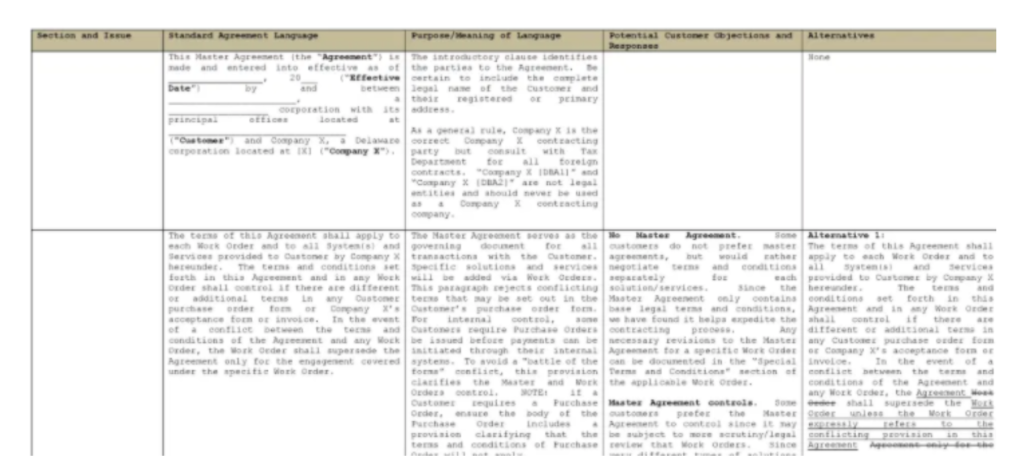
By Lexical Labs
Contract playbooks are now more important and easier to create than ever, but are unfortunately still underused. While critics express doubts about their use and overall effectiveness over the perceived time investment and their alleged inflexibility, the availability of better contract data and analytics, and the technology to digitise playbooks, are heralding an exciting time for the playbook.
We set out below the key ingredients of an effective playbook and our guide to setting up a playbook in less than 3 hours.
The benefits: time and money saved; better outcomes; demonstrated business value added by the legal team.

What is a contract playbook?
Contract playbooks come in different shapes and sizes, but broadly it is a guide that:
- Identifies the key points that are repeatedly negotiated in a contract and providing ideal and fall-back positions on those points
- Gives clear explanations to juniors or business colleagues on the desired outcomes and their importance
- Sets out any escalation points that need sign-off by seniors or other departments
- Gives appropriate contract wording to achieve the desired outcome
- Often contains the workflow and process around contract finalisation
What are the benefits?
The benefits include time saved training colleagues and reviewing contracts, better business outcomes, more consistency and a framework that allows for constant review of risk and business objectives across a contract portfolio. It provides a benchmark that can adapt to real world conditions over time.
Contract review can also be flexibly deployed between internal legal, contract managers, business managers and external providers – meaning better and cheaper resourcing with the same outcomes.
Why are they underused?
While this sounds fine in theory, the devil is in the detail and playbooks aren’t universally popular. Mainly, the perceived upfront time investment, lack of flexibility and the tendency to over complicate puts people off. Some playbooks run to 20-30 pages in quite a dense format, as seen in the image below.
There is often a misconception that they need to capture all or nearly all of the negotiation points and provide hard and fast rules. This needn’t be the case. Indeed, one of the most satisfying aspects of negotiating contracts is the exercise of common sense and judgment.

4 key ingredients for an effective playbook
1 – Customer and result orientated: Playbooks should aim to provide better business outcomes and a better customer experience in contract negotiation. Good playbooks address this by properly assessing and balancing the needs and interests of all stakeholders – the functions such as sales, procurement, risk, compliance and legal but also the people involved.
A short workshop involving all those stakeholders is a great way to kick off a playbook. Regular workshops and feedback sessions keep the playbook relevant.
Playbooks should promote process improvement. This might mean delegating contract review to more junior legal staff or outside providers, allowing business teams to ‘self serve’ on contracts or introducing contract automation technology. Depending on the objective, the form and content will be very different.
2 – Simple and effective design: Pareto’s principle (allowing 80% of the outcomes to be achieved by focusing on 20% of the inputs) is a great basis for a playbook. Perfection does not need to be the enemy of the good. As shown below, a simple but effective playbook can be generated in a few hours.
Simple design techniques can further enhance its effectiveness and impact on the audience. Think visual diagrams and creative ways of explaining legal outcomes.
3 – Effective use of data: A playbook should focus on business outcomes and address the trade-off that exists between the time and money expended in a negotiation and the desired outcome. Data is vital in informing the best negotiation approach.
For example, a playbook often provides rules for agreeing a sensible cap on liability under a contract. If this ignores practice in the market for similar contracts, the time expended negotiating that position or securing internal approvals for exceptions, the playbook can quickly defeat its own objectives.
The workshops mentioned above are a great source of both anecdotal and empirical data. Technology can provide further help.
4 – Smart use of technology: Technology is unlocking the true potential for playbooks in different ways.
First, it’s a great source of data analysis. For example, NLP based contract review systems can easily answer the fundamental question: “what have we negotiated in the past?” Before the development of this technology, it took days to answer. The advent of machine readable contracts will accelerate this trend.
Furthermore, greater sharing of contract data with technology platforms, as recently pioneered in LawTech UK’s Pilot Sandbox, will enable businesses to understand properly what is a ‘standard market position’ or provide easy access to common contract wording. Technology platforms also provide data around negotiation times and bottlenecks.
Second, contract assembly technologies can directly link to playbooks. Business teams can therefore generate playbook compliant contracts by completing a simple questionnaire. Fallback positions can also be stored in those systems.
Third, the playbook can itself be digitised on a technology platform that contains both NLP and playbook technology. The technology will automatically review a draft contract or a redline against the playbook, highlight problematic provisions and provide solutions in the form of suggested mark-up wording or comments or guidance. The system will automate a report of the draft contract against the playbook and capture the data for contract management purposes.
Digitised playbooks are easy to set-up and are dynamic. They can capture and analyse data and can be constantly adapted and improved. For example, knowhow such as new drafting can be tagged and shared by users. Guidance notes can be given by video. The current ‘live’ contract portfolio can be analysed against the playbook position – a much more important data point than assessing one particular contract.
Simple steps for playbook creation and continuous improvement
- Gather initial written materials such as a small sample of contracts, guides and preferred wording (if exists). Identify contracts to be covered by the playbook.
- Hold a 2 hour workshop with key business, legal and risk stakeholders – use an interactive whiteboard and/or post-it notes so each participant specifies their top 6-8 key (i) objectives (ii) most important provisions and (iii) most problematic / negotiated provisions. Use the 80:20 rule and agree 6-10 key items for the playbook. In the workshop – agree preferred position, acceptable fallback position and any escalation points. Write-up the playbook in the workshop – don’t leave till later. Don’t aim for perfection as it will change and improve periodically.
- (Optional) – Use NLP or similar technology to benchmark your current contract portfolio against the playbook. If the current portfolio is significantly misaligned, consider changing the playbook at the first review.
- (Optional) – Set-up your playbook in the contract assembly or contract review technology that you are using or have chosen to use.
- Use the playbook for 3-4 months then hold a first review meeting with the same team. If you have the technology and data available, score your recent contracts against the playbook and collect data on negotiation times and bottlenecks. Assess that data and anecdotal data from team members in the meeting and make changes to preferred positions, fallback positions and escalation triggers.
- Periodically review and improve the playbook every 3-4 months.

If you would like to learn more about Lexical Labs, please see here.
—
[ Artificial Lawyer is proud to bring you this sponsored thought leadership article by Lexical Labs. ]